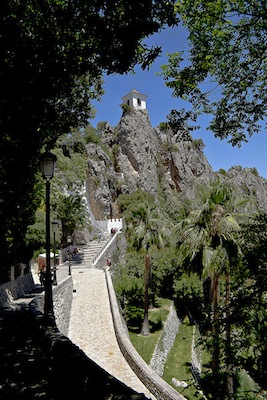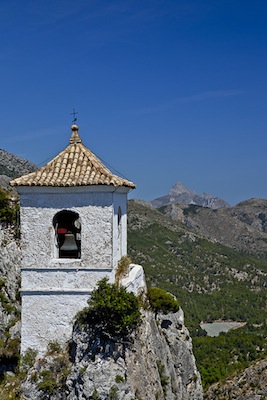By Des Townshend
 Seventeen miles from the bustling coastal city of Benidorm lies the rock-perched village of Guadalest, the most dramatically situated of all the Moorish fortifications that dot the mountains of the Costa Blanca.
Seventeen miles from the bustling coastal city of Benidorm lies the rock-perched village of Guadalest, the most dramatically situated of all the Moorish fortifications that dot the mountains of the Costa Blanca.
This settlement is made up of two villages referred to as the Old Village and the New Village. You walk through the Puerta de San Jose rock arch into the Old Village, where there are no cars, up the historic cobblestone paths, past the souvenir shops offering local crafts, and head towards the most unusual home you will ever see in what was Moorish Spain.
Literally situated on top of a huge mountain rock, and hardly visible from the road you drove up, the “Grand House” of El Castell de Guadalest — or Casa Orduna — was built after the great earthquake of 1644 that devastated the region. Following a rebuilding, it was plundered and burned to the ground during the War of Succession in 1708, only to be reconstructed once again.
You can imagine privileged children in medieval times running from the basement wine cellar through four levels, including the dining room, state rooms, library, and exhibition hall, and into the garden perched on the edge of the cliff with a solid wall to save them from a disastrous 600-foot fall. Anxious parents must have lectured their young ones to be careful, not only for their own safety, but also to protect the valuable artifacts left for us to enjoy, such as the huge urn, furnishings, and personal belongings signifying life in bygone years.
Recognizing the importance religion played in Spanish life, it is no surprise to see the six oil paintings in the entrance hall, each with a strong religious theme and typical of early European Renaissance. A very rare style of painting is hanging in the antechamber. A different image is painted on each side of the same canvas, showing the face and torso of Christ on one side and the bloody scars of thrashing on his back on the other. Both sides are visible simultaneously with the aid of a strategically positioned mirror.
 As you move through the well-designed (even by today’s standards) house, you can’t help noticing the picturesque vista through the grilled windows overlooking the New Village and the reservoir with its deep turquoise color. Capture a memorable shot of the iconic white bell tower, called Penon de la Alcala, from the overhanging garden.
As you move through the well-designed (even by today’s standards) house, you can’t help noticing the picturesque vista through the grilled windows overlooking the New Village and the reservoir with its deep turquoise color. Capture a memorable shot of the iconic white bell tower, called Penon de la Alcala, from the overhanging garden.
The Orduna family was the last to own this wonderful house until the remaining marquis died in 1949 without heirs and the estate went to distant relatives. Then some 45 years later the town council refurbished it, creating the well-maintained museum it is today.
Having enjoyed the stairway to Spanish medieval heaven, you head back down the steep stone steps and past the cemetery beside the family church to relax in the village square and recharge your batteries in one of the several outdoor cafes that serve Spanish coffee, beer, and soft drinks.
Travel tips for Guadalest, Spain
Location: 17 miles inland from Benidorm on the Spanish Costa Blanca Mediterranean coast with easy access from Valencia, Alicante, and Murcia
By car from Benidorm: Take CV-766 northeast to CV-7671 and follow the signs to CV-70 that will take you all the way to Guadalest. If you are not used to European roundabouts, give way to traffic already in the roundabout on your right.
Car rental: Prices for one week are from approximately100 euros ($123) for a compact to 560 euros ($690) for a full size. Prices vary by season.
Parking: Public parking is available in the New Village.
By bus: At the time of this writing there are tour buses from Alicante and Benidorm; however, there is a recession in Spain affecting many industries and availability should be checked.
Walking in the Old Village: The only way to enter the Old Village is by walking, as cars and buses are not allowed. Wear comfortable shoes for the cobbled pavement. Avoid flip-flops. Bottled water is recommended.
Restaurants: There are cafes in the Plaza San Gregorio in the Old Village but none are remarkable. The best restaurant in the area is Venta la Montana in Benimantell, 1.6 miles. Telephone 965-885-141.
Accommodation: There are two blocks of apartments for rent in Guadalest and one in Benimantell; all are rated with one or no stars. There are many alternatives on the Costa Blanca coast or in Murcia.
Local popular dish: Paella made with either seafood or pork.
If you’d like to purchase this article for your publication, click here to contact the author directly.
Most important information about generics
